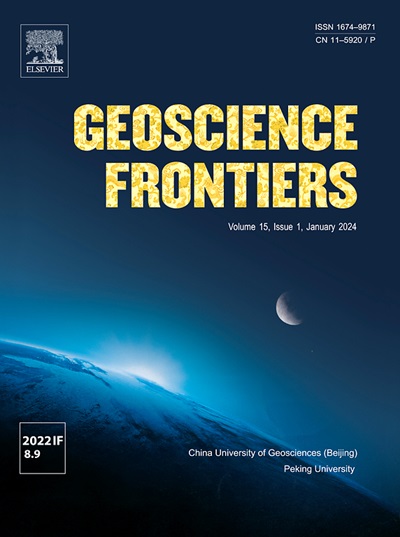Central Indian Ocean Basin micrometeorite collections: Type, flux, etching and its implication to ocean biogeochemistry
IF 8.9
1区 地球科学
Q1 GEOSCIENCES, MULTIDISCIPLINARY
引用次数: 0
Abstract
Extraterrestrial phenomena have influenced Earth’s processes throughout geological history. Evaluating the impact of extraterrestrial material on the environment is crucial for understanding the evolution of Earth and life. This study incorporates the investigation of micrometeorites (MMs), abundant cosmic materials on Earth, to understand their influence on the chemical composition and biogeochemistry of the ocean. Comprehensive etching and flux analyses reveal that ∼95% of cosmic spherules (CSs) entering seawater are etched or wholly dissolved, supplying nutrients to phytoplankton. Barred spherules show the highest degree of etching (∼19%), followed by porphyritic (∼17%), glass (∼15%), cryptocrystalline (∼12%), scoriaceous (∼10%), G-type (∼9%), and I-type (∼6%). Annually, ∼3080 tonnes (t) of olivine from MMs dissolve into seawater, contributing ∼495 t of Mg2+, ∼1110 t of Fe2+, and ∼1928 t of silicic acid. This signifies that over the Indian Ocean’s ∼40 Myr history, ∼23 Gt of olivine from CSs has dissolved, providing nutrients to seawater and sequestering ∼7 Gt of CO2. The world ocean during this time has sequestered ∼35 Gt of CO2, with fluctuations influenced by extraterrestrial activity. For instance, the Veritas event, lasting ∼1.5 Myr, sequestered ∼6 Gt of CO2 from the atmosphere. A robust flux calculation based on ∼2 t of deep-sea sediments from 3610 MMs provides a more accurate estimate of the time-averaged flux of ∼229 t yr−1. These comprehensive analyses reveal MM’s original characteristics, post-deposition processes, geological record and their overall impact on Earth’s marine environments, thereby contributing to our knowledge of the interconnection between terrestrial and extraterrestrial processes.

中印度洋盆地微陨石:类型、通量、蚀刻及其对海洋生物地球化学的意义
在整个地质历史中,外星现象影响着地球的进程。评估地外物质对环境的影响对于了解地球和生命的进化至关重要。本研究结合对地球上丰富的宇宙物质微陨石(micrometeorites, mm)的调查,了解其对海洋化学成分和生物地球化学的影响。综合蚀刻和通量分析表明,进入海水的宇宙球粒(CSs)约95%被蚀刻或完全溶解,为浮游植物提供营养。条状球粒的蚀刻程度最高(~ 19%),其次是卟啉(~ 17%)、玻璃(~ 15%)、隐晶(~ 12%)、碎屑(~ 10%)、g型(~ 9%)和i型(~ 6%)。每年,mm中的橄榄石约3080吨(t)溶解到海水中,贡献约495吨Mg2+,约1110吨Fe2+和约1928吨硅酸。这表明,在印度洋的~ 40myr历史中,来自CSs的~ 23gt橄榄石已经溶解,为海水提供营养并封存了~ 7gt的CO2。在此期间,世界海洋封存了约35亿吨的二氧化碳,其波动受到地外活动的影响。例如,Veritas事件持续了约1.5兆当量,从大气中吸收了约6亿吨二氧化碳。基于3610 mm深海沉积物~ 2 t通量的稳健通量计算提供了对~ 229 t yr−1的时间平均通量的更准确估计。这些综合分析揭示了MM的原始特征、沉积后过程、地质记录及其对地球海洋环境的总体影响,从而有助于我们了解陆地和地外过程之间的相互关系。
本文章由计算机程序翻译,如有差异,请以英文原文为准。
求助全文
约1分钟内获得全文
求助全文
来源期刊

Geoscience frontiers
Earth and Planetary Sciences-General Earth and Planetary Sciences
CiteScore
17.80
自引率
3.40%
发文量
147
审稿时长
35 days
期刊介绍:
Geoscience Frontiers (GSF) is the Journal of China University of Geosciences (Beijing) and Peking University. It publishes peer-reviewed research articles and reviews in interdisciplinary fields of Earth and Planetary Sciences. GSF covers various research areas including petrology and geochemistry, lithospheric architecture and mantle dynamics, global tectonics, economic geology and fuel exploration, geophysics, stratigraphy and paleontology, environmental and engineering geology, astrogeology, and the nexus of resources-energy-emissions-climate under Sustainable Development Goals. The journal aims to bridge innovative, provocative, and challenging concepts and models in these fields, providing insights on correlations and evolution.
 求助内容:
求助内容: 应助结果提醒方式:
应助结果提醒方式:


